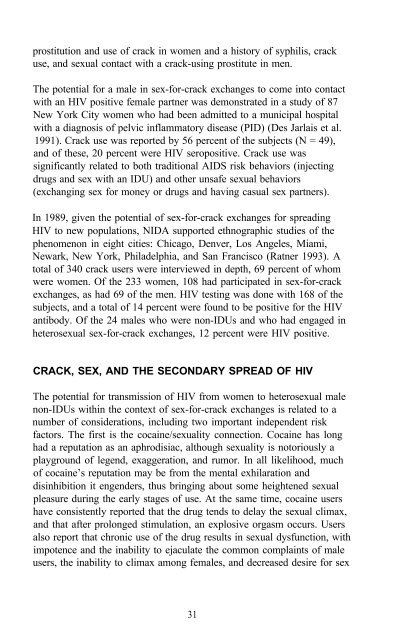The Context of HIV Risk Among Drug Users and Their Sexual Partners
The Context of HIV Risk Among Drug Users and Their Sexual Partners
The Context of HIV Risk Among Drug Users and Their Sexual Partners
You also want an ePaper? Increase the reach of your titles
YUMPU automatically turns print PDFs into web optimized ePapers that Google loves.
prostitution <strong>and</strong> use <strong>of</strong> crack in women <strong>and</strong> a history <strong>of</strong> syphilis, crack<br />
use, <strong>and</strong> sexual contact with a crack-using prostitute in men.<br />
<strong>The</strong> potential for a male in sex-for-crack exchanges to come into contact<br />
with an <strong>HIV</strong> positive female partner was demonstrated in a study <strong>of</strong> 87<br />
New York City women who had been admitted to a municipal hospital<br />
with a diagnosis <strong>of</strong> pelvic inflammatory disease (PID) (Des Jarlais et al.<br />
1991). Crack use was reported by 56 percent <strong>of</strong> the subjects (N = 49),<br />
<strong>and</strong> <strong>of</strong> these, 20 percent were <strong>HIV</strong> seropositive. Crack use was<br />
significantly related to both traditional AIDS risk behaviors (injecting<br />
drugs <strong>and</strong> sex with an IDU) <strong>and</strong> other unsafe sexual behaviors<br />
(exchanging sex for money or drugs <strong>and</strong> having casual sex partners).<br />
In 1989, given the potential <strong>of</strong> sex-for-crack exchanges for spreading<br />
<strong>HIV</strong> to new populations, NIDA supported ethnographic studies <strong>of</strong> the<br />
phenomenon in eight cities: Chicago, Denver, Los Angeles, Miami,<br />
Newark, New York, Philadelphia, <strong>and</strong> San Francisco (Ratner 1993). A<br />
total <strong>of</strong> 340 crack users were interviewed in depth, 69 percent <strong>of</strong> whom<br />
were women. Of the 233 women, 108 had participated in sex-for-crack<br />
exchanges, as had 69 <strong>of</strong> the men. <strong>HIV</strong> testing was done with 168 <strong>of</strong> the<br />
subjects, <strong>and</strong> a total <strong>of</strong> 14 percent were found to be positive for the <strong>HIV</strong><br />
antibody. Of the 24 males who were non-IDUs <strong>and</strong> who had engaged in<br />
heterosexual sex-for-crack exchanges, 12 percent were <strong>HIV</strong> positive.<br />
CRACK, SEX, AND THE SECONDARY SPREAD OF <strong>HIV</strong><br />
<strong>The</strong> potential for transmission <strong>of</strong> <strong>HIV</strong> from women to heterosexual male<br />
non-IDUs within the context <strong>of</strong> sex-for-crack exchanges is related to a<br />
number <strong>of</strong> considerations, including two important independent risk<br />
factors. <strong>The</strong> first is the cocaine/sexuality connection. Cocaine has long<br />
had a reputation as an aphrodisiac, although sexuality is notoriously a<br />
playground <strong>of</strong> legend, exaggeration, <strong>and</strong> rumor. In all likelihood, much<br />
<strong>of</strong> cocaine’s reputation may be from the mental exhilaration <strong>and</strong><br />
disinhibition it engenders, thus bringing about some heightened sexual<br />
pleasure during the early stages <strong>of</strong> use. At the same time, cocaine users<br />
have consistently reported that the drug tends to delay the sexual climax,<br />
<strong>and</strong> that after prolonged stimulation, an explosive orgasm occurs. <strong>Users</strong><br />
also report that chronic use <strong>of</strong> the drug results in sexual dysfunction, with<br />
impotence <strong>and</strong> the inability to ejaculate the common complaints <strong>of</strong> male<br />
users, the inability to climax among females, <strong>and</strong> decreased desire for sex<br />
31
















